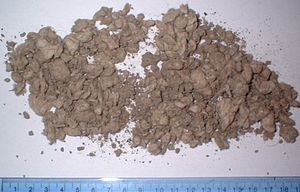- Digestate
-
Digestate is solid material remaining after the anaerobic digestion of a biodegradable feedstock. Anaerobic digestion produces two main products: digestate and biogas. Digestate is produced both by acidogenesis and methanogenesis and each has different characteristics.
Contents
Acidogenic digestate
Acidogenic digestate is fibrous and consists of structural plant matter including lignin and cellulose. Acidogenic digestate has high moisture retention properties. The digestate may also contain minerals and remnants of bacteria.
Methanogenic digestate
Methanogenic digestate is a sludge (sometimes called a liquor). This is often high in nutrients such as nitrates and phosphates.
Uses
The primary use of digestate is as a soil conditioner.[1] Acidogenic digestate provides moisture retention and organic content for soils. This organic material can break down further, aerobically in soil. Methanogenic digestate provides nutrients for plant growth. It can also be used to protect soils against erosion.
Acidogenic digestate can also be used as an environmentally friendly filler to give structure to composite plastics.
Growth trials on digestate originating from mixed waste have showed healthy growth results for crops.[2]
Application of digestate has been shown to inhibit plant diseases and induction of resistance. Digestate application has a direct effect on soil-born diseases, and an indirect effect by stimulation of biological activity.
Digestate and compost
Digestate is technically not compost although it is similar to it in physical and chemical characteristics. Compost is produced by aerobic digestion- decomposition by aerobes. This includes fungi and bacteria which are able to break down the lignin and cellulose to a greater extent.
Standards for digestate
The standard of digestate produced by anaerobic digestion can be assessed on three criteria, chemical, biological and physical aspects. Chemical quality needs to be considered in terms of heavy metals and other inorganic contaminant, persistent organic compounds and the content of macro-elements such as Nitrogen, Phosphourous and Potassium. Depending on their source, biowastes can contain pathogens, which can lead to the spreading of human, animal or plant diseases if not appropriately managed.
The physical standards of composts includes mainly appearance and odour factors. Whilst physical contamination does not present a problem with regards to human, plant or animal health, contamination (in the form of plastics, metals and ceramics) can cause a negative public perception. Even if the compost is of high quality and all standards are met, a negative public perception of waste-based composts still exists. The presence of visible contaminants reminds users of this.
Quality control of the feedstock is the most important way of ensuring a quality end product. The content and quality of waste arriving on-site should be characterised as thoroughly as possible prior to being supplied.
In the UK the Publicly Available Specification (called PAS110) governs the definition of digestate derived from the anaerobic digestion of source-segregated biodegradable materials [3]. The specification ensures all digested materials are of consistent quality and fit for purpose. If a biogas plant meets the standard, its digestate will be regarded as having been fully recovered and to have ceased to be waste, and it can be sold with the name “Bio- fertiliser” [4].
See also
- Anaerobic decomposition
- Anaerobic digester types
- Anaerobic digestion
- Biogas powerplant
- Biosolids
- Mechanical biological treatment
References
- ^ Evaluation of Opportunities for Converting Indigenous UK Wastes to Fuels and Energy (Report), NNFCC 09-012
- ^ Response to source segregation requirement, www.alexmarshall.me.uk, Retrieved 22.02.07
- ^ WRAP Anaerobic Digestion Page
- ^ UK's Official Information Portal on Anaerobic Digestion and Biogas, Digestate Standards Page
Topics related to waste management Anaerobic digestion · Composting · Downcycling · Eco-industrial park · Incineration · Landfill · Materials recovery facility · Mechanical biological treatment · PullApart · Radioactive waste · High-level radioactive waste management · Recycling · Regift · Reuse · Septic tank · Sewerage · Sewage regulation and administration · Upcycling · Waste · Waste collection · Waste hierarchy · Waste legislation · Waste management · Waste management concepts · Waste sorting · Waste treatmentCategories:- Anaerobic digestion
- Biodegradable waste management
- Mechanical biological treatment
- Soil improvers
Wikimedia Foundation. 2010.

